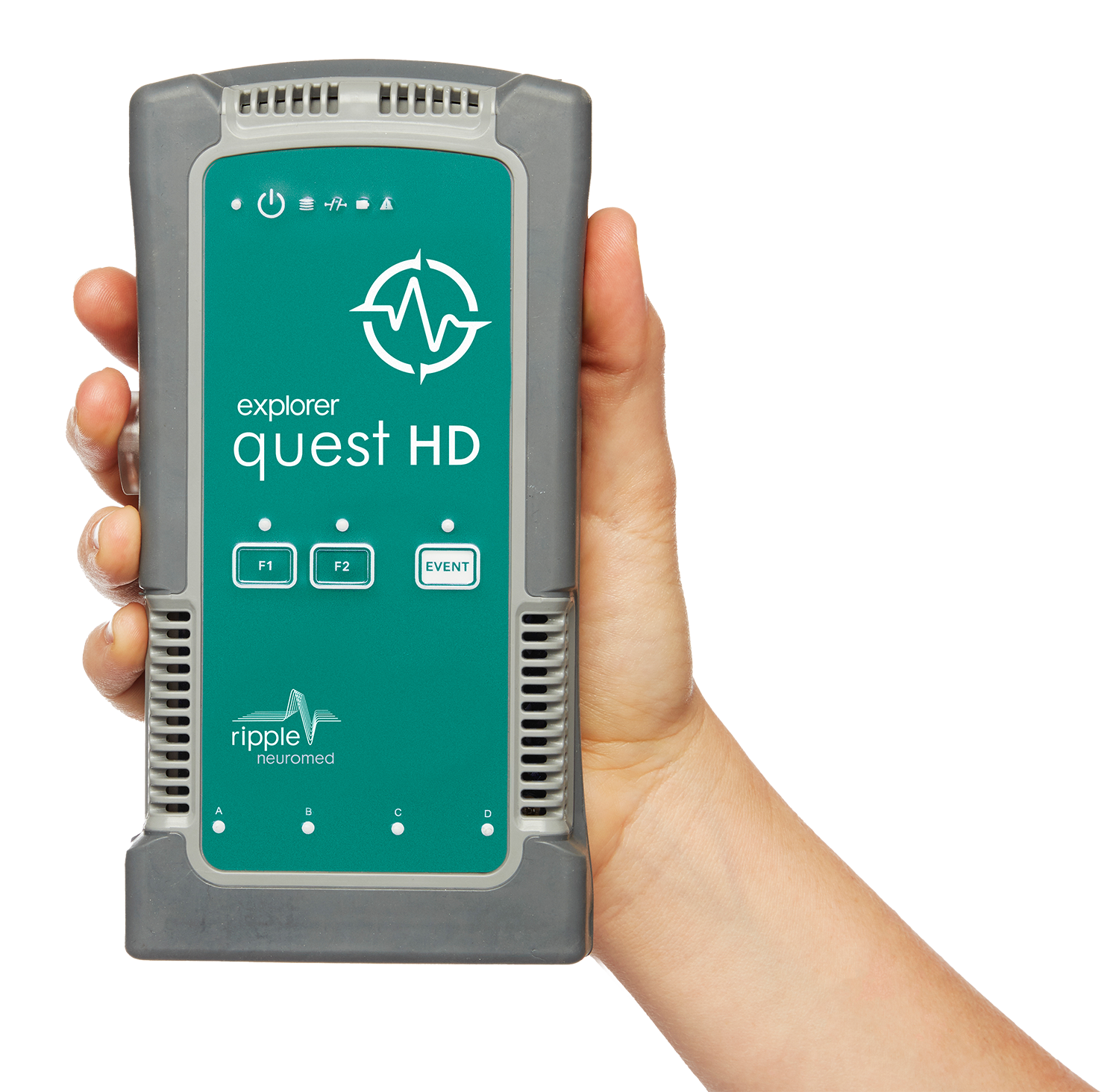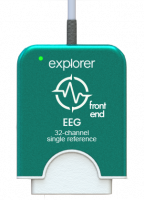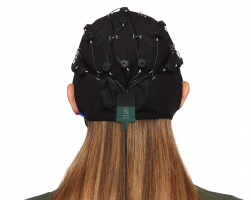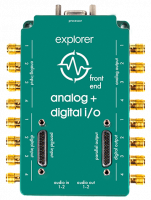QUEST HD | MOBILE EEG & ERP SYSTEM
A Portable, Wireless, Full-Featured EEG/ERP and EMG System
The Explorer Quest HD
A Portable, Wireless, Full-Featured EEG/ERP and EMG System
Research can take you many places. Ripple Neuromed’s Quest HD ensures you are always prepared with a full-featured, multi-modal EEG, ERP, and EMG solution.
Stream data wirelessly or save it to the Quest HD’s internal storage for an untethered system that is just as capable inside the lab as it is on the road.
With true high-density capabilities, the Quest HD can record up to 256 EEG channels with an additional 64 EMG channels. Optimized for the highest quality data acquisition, the Quest HD features 24-bit resolution and a sampling rate of 7.5 ksps.
Achieve maximum flexibility in your recordings with the full line of Explorer products, including dedicated EEG and Physio Front Ends. The Quest HD kit comes standard with a Digital I/O module offering 20 additional inputs and outputs to interface with stimulus presentation systems and external devices.
Highlights
- Portable and wireless EEG/ERP
- Active Front Ends achieve the signal quality of active electrodes with the durability and robustness of passive electrodes
- Broad compatibility with most electrode technologies
- Meets safety standards for laboratory and clinical research
Up to 256 channels
of EEG recording
7.5 kHz sampling rate
for the highest quality data
Portable – Use in the lab or on the go.
Active Front Ends – Unparalleled signal fidelity. Robustness of passive electrodes.
Electrode and Cap Support –Most EEG electrode technologies. Use your current caps and nets.
Wearable – Wireless communication. Integrated Battery. On-board storage. Pack it up and go
Real-Time, Closed-Loop Control – Programmatic Control. Real-time feedback. MATLAB & Python.
PORTABLE & WEARABLE
Leave the lab behind by utilizing the Quest HD’s wireless data transmission, internal data storage, and integrated battery. At merely 700 grams, the Quest HD offers a truly mobile experience.
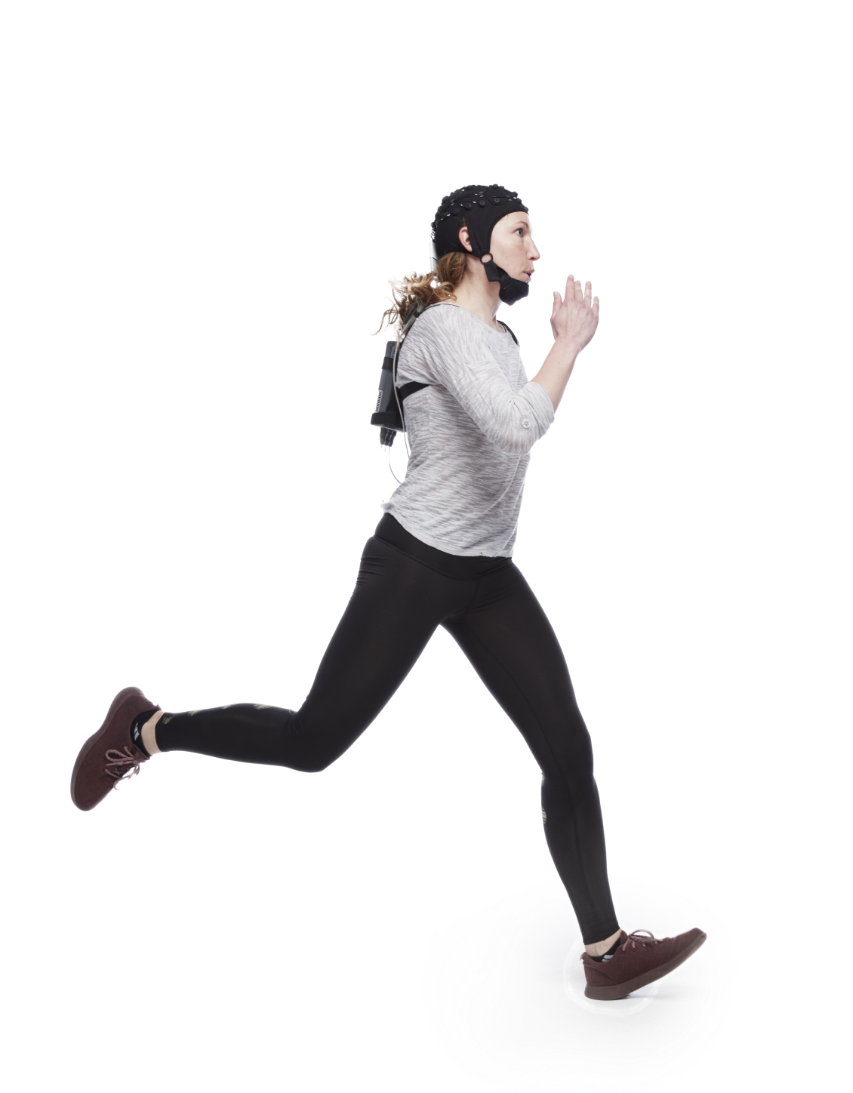
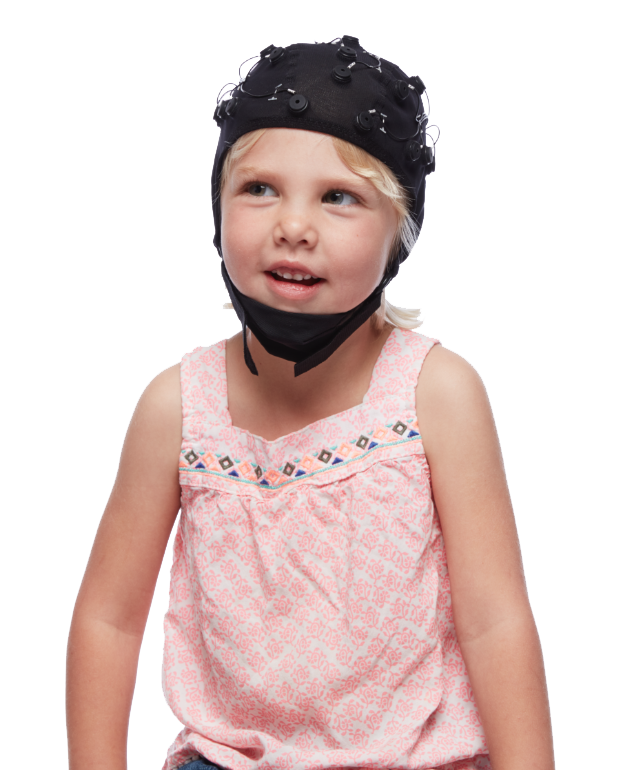
BROAD THIRD-PARTY ELECTRODE AND CAP SUPPORT
Ripple Neuromed provides our users with adapters to connect to most EEG electrode technologies, allowing them to continue using caps or nets they have in house or that are specific to their research.
Complete your System

Quest HD
Turn-Key Mobile EEG and ERP
Small and lightweight, the Quest HD frees your subjects to move freely and engage in natural behavior. Capable of true high density recording with a max channel count of up to 512 channels, with 24-bit resolution and sampling rate of 7.k ksps for the highest quality data.
Integrating with the Explorer line’s Compass software allows for turn-key setup with automatic device and accessory recognition, and an array of useful features including real-time impedance measurement, integrated video tracking through multiple USB cameras, and graphical control of ERP triggers and configuration.
The Quest HD elimates the need for cables, featuring wireless data transmission, an integrated battery, and internal data storage. With on-board processing, and a bevy of inputs and outputs, and a powerful yet user-friendly API, the Quest HD can be custom programmed for your unique paradigms with real-time control of external devices, stimulators and trackers. In addition to EEG and ERPs, the Quest is also compatible with the Explorer EMG front end for concurrent bipolar EMG recordings.
Highlights
- A completely wearable EEG/ERP solution, with wireless communication and on-board data storage
- On-board processing and an easy-to-use API for custom applications
- Meets safety standards for laboratory and clinical research
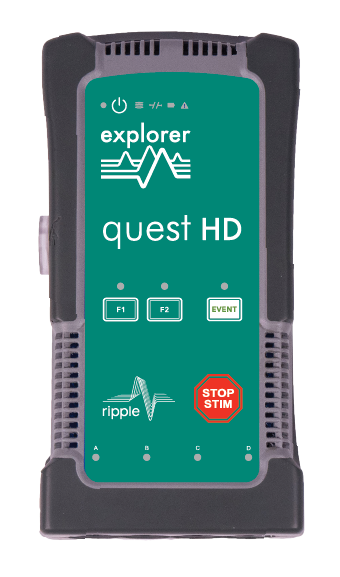
Specifications
Quest HD Processor
| Number of Channels | up to 512 |
| Analog I/O | up to 28 inputs and 28 outputs |
| Digital I/O | up to 20 input and 20 outputs, plus 2 strobes |
| Battery Life | Internal, up to 2 hours; External, 4 – 6 hours |
| Data Communication with PC | Gigabit Ethernet or Wi-Fi |
| Dimensions | 183 mm x 95 mm x 36 mm |
| Weight | 700 g |
Recording
| Resolution | 24-bit |
| Inferred Noise | <1 μVrms |
| Common Mode Rejection Ratio | -110dB |
| Input Range Min | ± 0.1875 V at a gain of 24 |
| Input Range Max | ± 2 V at a gain of 1 |
| Input Impedance | 1 GΩ, 20 pF |
Quest HD+Stim
Concurrent Transcranial Stimulation and Electroencephalography
Adding to the mobility and features of the Quest HD, the Quest HD+Stim add the ability to do concurrent tCS along with your EEG and ERP recordings.
Powerful on-board processing allows for generation of complex waveforms, allowing you to use common tCS modalities (such as tDCS, tACS, tPCS or tRCS) or experiment with novel waveforms, even modulating or creating stimuli based on the subject’s behavioral or electrophysiological responses. Stimulation can be applied to any of the recording channels, with a switch time of less than a millisecond.
Highlights
- Concurrent tCS and EEG/ERP
- Selectable stimulation channels (switch time < 1ms)
- Closed-loop control of tCS parameters
- All of the mobility and features of the Quest HD
- Meets safety standards for laboratory and clinical research
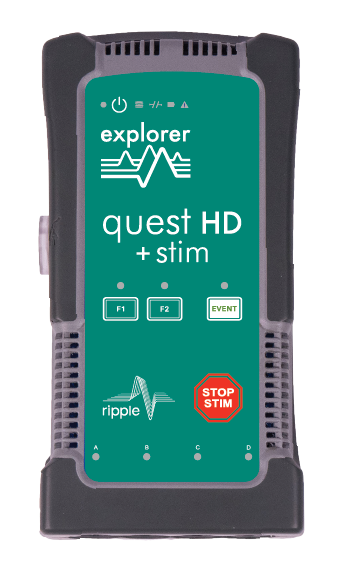
Specifications
Quest HD Processor
| Number of Channels | up to 512 |
| Analog I/O | up to 28 inputs and 28 outputs |
| Digital I/O | up to 20 input and 20 outputs, plus 2 strobes |
| Battery Life | Internal, up to 2 hours; External, 4 – 6 hours |
| Data Communication with PC | Gigabit Ethernet or Wi-Fi |
| Dimensions | 183 mm x 95 mm x 36 mm |
| Weight | 700 g |
Recording
| Resolution | 24-bit |
| Inferred Noise | <1 μVrms |
| Common Mode Rejection Ratio | -115dB |
| Input Range Min | ± 0.1875 V at a gain of 24 |
| Input Range Max | ± 2 V at a gain of 1 |
| Input Impedance | 300 MΩ, 150 pF |
Stimulation
| Current Range | 100 μA – 15 mA |
| Compliance Voltage | ± 9 V to ± 30 V (configurable) |
| Pulse Width Min | 33μs |
| Bandwidth | DC to 120kHz |
The EEG family of front ends were designed for noninvasive surface electrodes. As the name implies, it is designed with EEG specifically in mind, however it is suitable for any surface recordings that do not require bipolar or true differential referencing (for these applications the Physio16 is recommended). The stimulation version, the EEG+tES, is designed for stimulation from surface electrodes, such as transcranial stimulation (tCS), or transcutaneous nerve or spinal stimulation (TENS, TSS).
EEG and EEG+tES
Features
- Compatible with any passive EEG cap
- Small, multichannel amplifier combines the signal quality of active caps with the ease-of-use and robustness of passive caps
- Combined with the Quest HD, is ideal for Mobile EEG/ERP
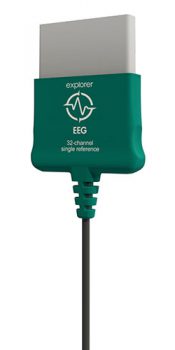
Primary Use Cases
- EEG
- ERP
- tCS
- TENS
- TSS
Specifications
| EEG | |
| Compatible Processors | Summit or any Quest HD |
| Channels | 32 or 128, single reference |
| Bit Depth | 24-bit |
| Resolution | 0.022 μV/bit |
| Sample Rate | 7.5 ksps |
| Bandwidth | DC to 2kHz |
| CMMR | 110 dB |
| Inferred Noise | <1 µVrms at 7.5 ksps |
| Input Range Min | ± 0.1875 V at a gain of 24 |
| Input Range Max | ± 2 V at a gain of 1 |
| Input Impedance | 1 Gohm, 20 pF |
| EEG+tES | |
| Compatible Processors | Summit or Quest HD+stim |
| Channels | 32 or 128, single reference |
| Bit Depth | 24-bit |
| Resolution | 0.022 μV/bit |
| Sample Rate | 7.5 ksps |
| Bandwidth | DC to 2kHz |
| CMMR | 110 dB |
| Inferred Noise | <1 µVrms at 7.5 ksps |
| Input Range Min | ± 0.1875 V at a gain of 24 |
| Input Range Max | ± 2 V at a gain of 1 |
| Input Impedance | 1 Gohm, 20 pF |
| Stimulation Waveforms | tDCS, tRNS, tACS, tPCS, user defined |
| Stimulation Current Range | ±15 mA |
| Compliance Voltage | ±9 to 30V (configurable) |
| Min Pulse Width | 33 µs |
| Stimulation Frequency | up to 15kHz |
The Explorer line offers two families of front ends for invasive recordings, the Micro2 and the Macro. The Micro2 was designed with high-impedance, micro electrodes in mind. Capable of recording single units, it has a sampling rate of up to 30 ksps. The Micro2+stim is capable of stimulating on all channels simultaneously, making it ideal for all manner of research applications. To avoid delivering excess power to high-impedance electrodes, the Micro2+stim has a lower maximum per channel current compared to the macro
The Macro was designed for standard clinical electrodes. Compared to the Micro2, it has a more focused bandwidth to optimize it for applications such as high-resolution ECoG or sEEG. The Macro2+Stim maximum stimulation current is higher to match common clinical stimulators, while limiting current flow to one anode and one cathode per 16 channel bank to prevent excessive discharge. However, due to the fast switching times common to all Ripple Neuromed stimulating front ends, all channels can be effectively stimulated at once by using interleaved pulse trains.
Macro and Macro+stim Front Ends
Features
- Compatible with macro and microelectrodes
- 1.5mm touchproof connector interface
- Constant current and constant voltage output modes
- One selectable stimulation channel (switch time < 1ms)
- Monopolar or bipolar waveforms
- Programmatic control of waveforms and train parameters
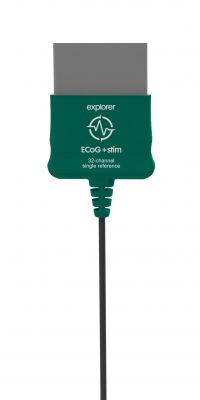
Primary Use Cases
- ECoG
- sEEG
- LFPs
- DBS
- Closed-Loop Stimulation
Specifications
| Macro | |
| Compatible Processors | Summit |
| Channels | 32 or 128, single reference |
| Bit Depth | 24-bit |
| Resolution | 0.022 μV/bit |
| Sample Rate | 7.5 ksps |
| Bandwidth | DC to 2kHz |
| CMMR | 110 dB |
| Inferred Noise | <1 µVrms at 7.5 ksps |
| Input Range Min | ± 0.1875 V at a gain of 24 |
| Input Range Max | ± 2 V at a gain of 1 |
| Input Impedance | 1 Gohm, 20 pF |
| Macro+stim | |
| Compatible Processors | Summit |
| Channels | 32 or 128, single reference |
| Bit Depth | 24-bit |
| Resolution | 0.022 μV/bit |
| Sample Rate | 7.5 ksps |
| Bandwidth | 0.03 Hz to 2kHz |
| CMMR | 110 dB |
| Inferred Noise | <1 µVrms at 7.5 ksps |
| Input Range Min | ± 0.1875 V at a gain of 24 |
| Input Range Max | ± 2 V at a gain of 1 |
| Input Impedance | 1 Gohm, 150 pF |
| Stimulation Current Range | ±15 mA |
| Compliance Voltage | ±9 to 30V (configurable) |
| Min Pulse Width | 33 µs |
| Stimulation Frequency | up to 15kHz |
Micro2 and Micro2+stim Front Ends
Features
Features
- High resolution, high sampling rate (30 ksps) recording
- Stimulation on all channels
- Programmatic control of waveforms and train parameters
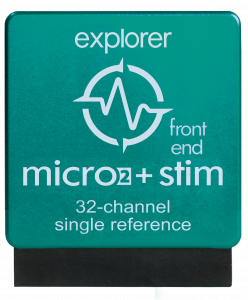
Primary Use Cases
- Single unit/multi-unit activity
- ECoG
- LFPs
- Closed-Loop Stimulation
| Micro2 | |
| Compatible Processors | Summit |
| Channels | 32, single reference |
| Bit Depth | 24-bit |
| Resolution | 0.125, 0.25, or 0.5 μV/bit |
| Sample Rate | 30 ksps |
| Bandwidth | 0.1 Hz to 2 kHz |
| CMMR | 82 dB |
| Inferred Noise | 2.1 µVrms |
| Input Range Min | ± 4 mV |
| Input Range Max | ± 12 V |
| Micro2+stim | |
| Compatible Processors | Summit |
| Channels | 32, single reference |
| Bit Depth | 24-bit |
| Resolution | 0.125, 0.25, or 0.5 μV/bit |
| Sample Rate | 30 ksps |
| Bandwidth | 1 Hz to 7.5 kHz |
| CMMR | 82 dB |
| Inferred Noise | 2.1 µVrms |
| Input Range Min | ± 4 mV |
| Input Range Max | ± 12 mV |
| Stimulation Current Range | ±1.5 mA |
| Compliance Voltage | ±8.5V |
| Min Pulse Width | 33 µs |
| Stimulation Frequency | up to 15kHz |
The Physio was designed specifically with electromyography in mind, although can be used for any type of electrophysiology from the body, such as ECG or noninvasive peripheral nerve recordings. It comes in both a 32 channel shared reference version, as well as a 16 channel bipolar version. The Physio does not have a stimulating version, but can be used with stimulating front ends for applications that need stimulation, such as electrically evoked potentials.
Physio 16 and Physio 32 Front Ends
Features
- 16 differential pairs or 32 single-ended channels
- Designed for bipolar EMG or single-ended HD EMG recordings
- 52 mm x 36 mm x 4.75 mm
- 13.5 g
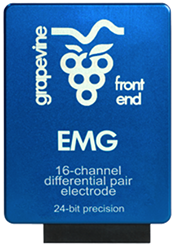
Primary Use Cases
- EMG
- MEP
- Noninvasive Peripheral Nerve recordings
Specifications
| Physio16 |
|
| Compatible Processors | Summit or any Quest HD |
| Channels | 16, true differential referencing |
| Bit Depth | 24-bit |
| Resolution | 0.022 μV/bit |
| Sample Rate | 7.5 ksps |
| Bandwidth | DC to 2kHz |
| CMMR | 110 dB |
| Inferred Noise | <1 µVrms at 7.5 ksps |
| Input Range Min | ± 0.1875 V at a gain of 24 |
| Input Range Max | ± 2 V at a gain of 1 |
| Input Impedance | 1 Gohm, 20 pF |
| Physio32 | |
| Compatible Processors | Summit or any Quest HD |
| Channels | 32, single reference |
| Bit Depth | 24-bit |
| Resolution | 0.022 μV/bit |
| Sample Rate | 7.5 ksps |
| Bandwidth | DC to 2kHz |
| CMMR | 110 dB |
| Inferred Noise | <1 µVrms at 7.5 ksps |
| Input Range Min | ± 0.1875 V at a gain of 24 |
| Input Range Max | ± 2 V at a gain of 1 |
| Input Impedance | 1 Gohm, 20 pF |
